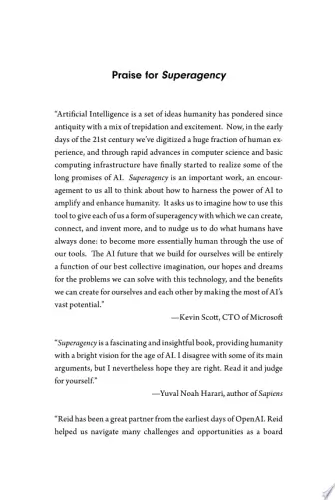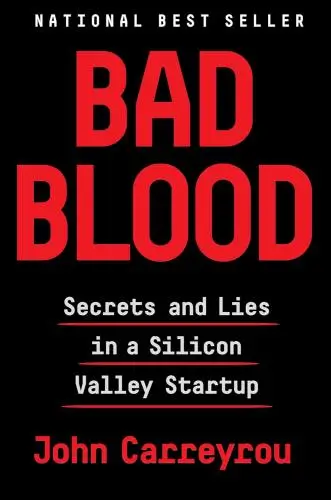Bad Blood
Secrets and Lies in a Silicon Valley Startup
What's it about?
Bad Blood uncovers the astonishing rise and fall of Theranos, the once-celebrated biotech startup led by Elizabeth Holmes. With riveting precision, Carreyrou reveals the behind-the-scenes fraud that propelled Theranos to fame, despite its technology that never worked. This gripping narrative exposes the dangerous mix of ambition, secrecy, and deception within Silicon Valley, serving as a cautionary tale about the perils of innovation without integrity. A must-read for anyone fascinated by the dynamics of power and the consequences of unchecked ambition.
About the Author
John Carreyrou is an investigative journalist best known for his work in exposing the Theranos scandal. With a detailed and meticulous approach, his reporting in The Wall Street Journal led to a book, "Bad Blood: Secrets and Lies in a Silicon Valley Startup," acclaimed for its thorough analysis and compelling narrative.
10 Key Ideas of Bad Blood
The Importance of Due Diligence in Business Partnerships
Before entering into any business partnership or investment, it's crucial to conduct thorough due diligence.
This involves verifying all claims made by the potential partner, including their technology, financial health, and legal standings.
In the case of Theranos, many investors and partners failed to verify the company's claims about its revolutionary blood testing technology, leading to significant financial and reputational losses.
Due diligence helps identify potential red flags and avoid costly mistakes.
Learn DeeperResearch the Company's Background: Start by looking into the company's history, leadership team, and track record. Use online resources, news articles, and industry reports to gather as much information as possible.
Verify Claims Independently: Don't take the company's word for it. If they claim to have revolutionary technology or significant partnerships, look for patents, scientific papers, or press releases from the alleged partners to confirm these claims.
Consult with Experts: If the business involves specialized technology or markets, consult with experts in those fields. They can provide insights that you might not be aware of and help validate the company's claims.
Review Financial Statements: Request and review the company's financial statements. Look for red flags like consistent losses, high debt levels, or irregularities in their reporting.
Conduct Legal Due Diligence: Check for any ongoing or past legal issues. This includes lawsuits, regulatory actions, or compliance issues. Such legal problems could indicate deeper issues within the company.
- Example
Before investing in a startup claiming to have a groundbreaking clean energy solution, an investor conducts independent tests of the technology through a third-party laboratory to verify its efficiency claims.
- Example
A business considering a partnership with a software company hires an IT consultant to review the software's codebase and security features, ensuring it meets industry standards and hasn't overstated its capabilities.
The Dangers of Overpromising and Underdelivering
While ambition is important, setting realistic expectations is crucial for long-term success.
Overpromising and underdelivering can damage a company's reputation, lead to mistrust among stakeholders, and ultimately result in failure.
Theranos made bold claims about its technology that it couldn't fulfill, misleading partners, investors, and the public.
It's essential to have a solid foundation and proof of concept before making grandiose claims.
Learn DeeperSet Achievable Goals: When planning a project or setting company milestones, ensure that your goals are realistic and achievable within the given timeframe. Use data and past performance as a guide to setting future targets.
Communicate Transparently with Stakeholders: Keep investors, customers, and team members in the loop about progress and challenges. Honesty builds trust, even when the news isn't what they hoped for.
Validate Your Product or Service Early and Often: Before making public claims about your product or service, conduct thorough testing and seek feedback from a small, controlled group of users. This can help catch potential issues before they become larger problems.
Learn from Feedback and Be Ready to Pivot: If feedback indicates that your product or service isn't meeting expectations, be prepared to make changes. Flexibility and responsiveness to feedback can turn potential failures into successes.
Avoid the Hype Trap: While it's tempting to use grandiose language to generate excitement about your product or service, focus on clear, honest communication that accurately reflects its current state and potential.
- Example
A tech startup developing a new app decides to release a beta version to a select group of users before officially launching. This allows them to gather feedback and make necessary adjustments, ensuring that their final product meets user expectations and avoids the pitfalls of overpromising.
- Example
A small business owner planning to expand their product line shares realistic timelines and potential challenges with their customers through regular updates via email and social media. This approach keeps customers informed and builds trust, even if delays occur.
The Role of Ethical Leadership in Guiding Company Values
Leaders set the tone for company culture and values.
Ethical leadership involves leading by example, making decisions based on integrity, and prioritizing the well-being of employees, customers, and the broader community.
The leadership at Theranos demonstrated a lack of ethical consideration, prioritizing personal gain and company valuation over honesty and safety.
Ethical leaders inspire trust and loyalty, which are invaluable assets for any organization.
Learn DeeperLead with Transparency: Make it a habit to communicate openly with your team. Share both successes and challenges. This builds trust and encourages a culture of honesty.
Prioritize Ethics in Decision Making: Before making decisions, consider the ethical implications. Ask yourself, 'Is this decision fair? Is it honest? Will it harm anyone?' This practice ensures that your actions align with ethical leadership.
Encourage Accountability: Hold yourself and your team members accountable for your actions. If mistakes are made, acknowledge them, learn from them, and move forward. This fosters a culture of responsibility and growth.
Promote a Culture of Respect and Inclusivity: Treat all employees and stakeholders with respect, regardless of their position or background. Encourage diversity of thought and inclusivity in all company activities.
Invest in Employee Development: Show your commitment to your team's well-being by investing in their professional growth. Offer training, mentorship, and opportunities for advancement. This demonstrates that you value them beyond their immediate output.
- Example
A CEO regularly holds open forums where employees at all levels can voice their concerns and suggestions. This practice not only makes the employees feel valued but also helps in identifying potential ethical issues before they escalate.
- Example
A manager faces a dilemma between choosing a cost-effective but environmentally harmful material or a more expensive eco-friendly option. By opting for the eco-friendly option and explaining the decision to the team, the manager sets a precedent for ethical decision-making and corporate responsibility.
Understanding the Impact of Technological Limitations
It's vital to have a realistic understanding of the current technological capabilities and limitations.
Pushing for innovation is necessary, but claiming to have achieved breakthroughs without solid evidence is misleading and dangerous.
Theranos claimed to have revolutionized blood testing with technology that was, in reality, non-functional and unreliable.
Acknowledging technological limitations allows for genuine progress and innovation through research and development.
Learn DeeperResearch Before You Leap: Before investing time, money, or belief in a new technology, do your homework. Look for peer-reviewed studies, credible reviews, and real-world applications of the technology. This helps in understanding its current capabilities and limitations.
Embrace Skepticism: Healthy skepticism allows you to question claims and seek evidence. If a company or technology promises revolutionary results, ask for proof. Look for data, independent validations, and user testimonials that support these claims.
Foster Transparency: Whether you're developing a product or evaluating one, advocate for transparency. If you're on the development side, share your progress, challenges, and the realistic capabilities of your technology. As a consumer or investor, demand this transparency to make informed decisions.
Prioritize Continuous Learning: The tech landscape is always evolving. Stay informed about advancements and setbacks in your field of interest. This ongoing education can help you better assess the feasibility and potential impact of new technologies.
Build a Network of Experts: Surround yourself with knowledgeable individuals in the field. Their insights can help you navigate the complexities of new technologies, discerning between genuine breakthroughs and overhyped claims.
- Example
Before investing in a startup claiming to use AI for diagnosing diseases from simple scans, you decide to look up existing research on the topic. You find that while there's promising progress, the technology is not yet at the level the startup claims. This research saves you from making a potentially risky investment.
- Example
You're considering a new fitness tracker that claims to accurately monitor blood sugar levels non-invasively. Instead of taking the marketing at face value, you search for user reviews and scientific validations. You discover that the technology, while innovative, still has limitations and inaccuracies, leading you to hold off on the purchase until it's more developed.
The Necessity of Independent Verification and Testing
Independent verification of product claims and technology is essential for maintaining credibility and ensuring safety.
External audits and tests can provide unbiased assessments that help companies improve their products and services.
Theranos avoided independent verification, which allowed them to continue making false claims about their technology.
Regular, independent evaluations ensure that a company's offerings meet industry standards and are safe for public use.
Learn DeeperResearch Before You Trust: Before investing in a product or service, especially one that claims to be revolutionary, take the time to research the company. Look for independent reviews, studies, or tests that verify the claims made.
Ask for Evidence: If you're in a position to do so (as a consumer, investor, or partner), don't hesitate to ask for evidence of claims. Companies confident in their technology should be willing to provide proof or allow for third-party verification.
Stay Informed About Industry Standards: Keep yourself updated on the standards and expectations within the industry of interest. Knowing what is considered 'normal' can help you spot when something seems off or too good to be true.
Encourage Transparency: Whether you're part of an organization or a consumer, advocate for transparency in operations and claims. Support businesses that are open about their processes and willing to undergo independent evaluations.
- Example
If considering a new health device that claims to diagnose diseases with minimal effort, look for FDA approvals or clinical trial results published in reputable medical journals.
- Example
Before investing in a startup that promises a groundbreaking technology, check for patents, peer-reviewed publications, or demonstrations at respected industry conferences.
Deeper knowledge. Personal growth. Unlocked.
Unlock this book's key ideas and 15M+ more. Learn with quick, impactful summaries.
Read Full SummarySign up and read for free!
Bad Blood Summary: Common Questions
Experience Personalized Book Summaries, Today!
Discover a new way to gain knowledge, and save time.
Sign up for our 7-day trial now.
No Credit Card Needed

Similar Books

Mathematics for Machine Learning
Marc Peter Deisenroth
Clinical Microbiology
Parslow
Medical Laboratory Science Review
Robert R Harr
Superagency
Reid Hoffman
Artificial Intelligence
Nicola Acocella
Frankenstein
Mary Shelley
The Circle
Dave Eggers
Roitt's Essential Immunology
Peter J. Delves
Laws of UX
Jon Yablonski
Structures
J. GordonTrending Summaries

Peak
Anders Ericsson
Never Split the Difference
Chris Voss
Smart Brevity
Jim VandeHei
The Psychology of Money
Morgan Housel
The First 90 Days
Michael D. Watkins
Atomic Habits
James Clear
Thinking, Fast and Slow
Daniel Kahneman
The Body Keeps the Score
Bessel van der Kolk M.D.
The Power of Regret
Daniel H. Pink
The Compound Effect
Darren HardyNew Books

The ^AOxford Handbook of Job Loss and Job Search
Ute-Christine Klehe PhD
Job Interviews For Dummies®
Joyce Lain Kennedy
Job Interviews In A Week
Alison Straw
Handbook of Career Development
Gideon Arulmani
The Art of Spending Money
Morgan Housel
$100M Offers
Alex Hormozi
A Candle for Kiri
Edna Mae Holm
Principles of Marketing, Global Edition
Gary Armstrong
Serpent Rising: The Kundalini Compendium
Neven Paar

